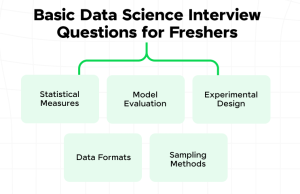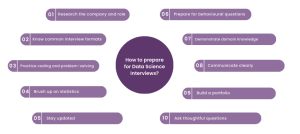
Data Science Interview Questions & Answers | Prepare to Ace Your Interview
Data science interviews are difficult. They don’t resemble your ordinary job interview in which either the technical ability or soft skills are the center of attention. Rather, data science interview questions are an entire package of statistics, machine learning, SQL, coding practice problems, case studies, and also business problem-solving, all combined into one.
So if you’ve been asking yourself, “How do I even begin preparing? What types of questions do I get? How do I approach them without freezing up on the spot?” You’ve come to the right place. Consider this a step-by-step guide to acing your data science interview questions.
Table Of Content
Data Science Interview Questions for Freshers
Core Technical Data Science Interview Questions
Advanced Data Science & Machine Learning Interview Questions
Behavioral & HR Interview Questions for Data Science
How to Prepare for a Data Science Interview Questions
How Jaro Education Can Help You Succeed in Data Science Interview Questions
Conclusion
Frequently Asked Questions
Data Science Interview Questions for Freshers

Core Technical Data Science Interview Questions
Advanced Data Science & Machine Learning Interview Questions
Behavioral & HR Interview Questions for Data Science
How to Prepare for a Data Science Interview Questions

Data science interview questions often follow a structured path, but each company adds its own twist. That unpredictability is exactly why a guided preparation strategy is important. To succeed, you need to combine fundamentals, tools, and clear communication because that’s what most data science interview questions are designed to test.
- Brush Up on Core Concepts: Revisit statistics, machine learning, programming, and SQL, these are the backbone of most data science interview questions.
- Get Hands-On with Tools: Show recruiters you can apply theory with visualization, big data, and cloud platforms.
- Solve Practice Problems: Platforms like LeetCode, HackerRank, and Kaggle sharpen logic and real-world problem-solving.
- Practice Explaining Work: Learn to clearly restate problems, walk through solutions, and discuss trade-offs.
- Polish Soft Skills: Translate technical results into simple, business-focused insights that decision-makers understand.
How Jaro Education Can Help You Succeed in Data Science Interview Questions
If you’re looking to upskill or planning a career switch into data science, at Jaro Education, we offer programs that help you strengthen your fundamentals and build the confidence to tackle real-world challenges. These skills directly prepare you for handling even the most demanding data science interview questions.
One of our top data science programs tailored for aspiring professionals preparing to ace data science interview questions is:
Online Master of Science (Data Science) – Symbiosis School for Online and Digital Learning (SSODL)
- Flexible online format designed for working professionals
- Balanced curriculum combining strong theoretical foundations with real-world case studies
By enrolling in this program, you’ll not only build strong technical expertise but also gain the problem-solving mindset needed to confidently face data science interview questions in your next job opportunity.
Conclusion
Acing data science interview questions is not about memorization. It’s about demonstrating to interviewers how you think, how you reason, and how you convert raw numbers into decisions.
Remember:
- Practice consistently.
- Prioritize clarity over complexity.
- Be enthusiastic about learning.
All the best with your data science interview preparation!
Frequently Asked Questions
The most common data science interview questions focus on statistics, SQL, machine learning basics, Python, and case studies.
Most data science interview questions only need a solid grasp of probability, statistics, and linear algebra—not advanced math.

